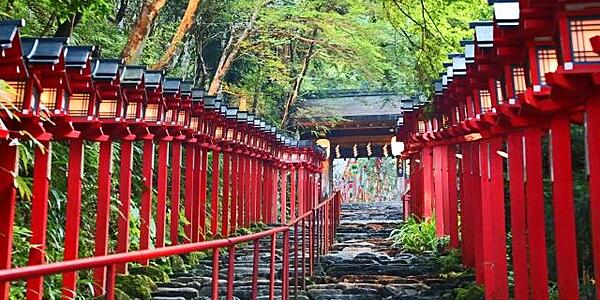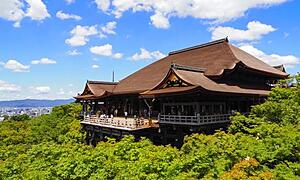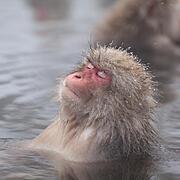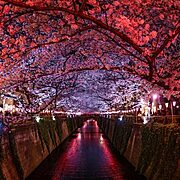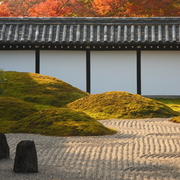Renowned as one of Kyoto's premier power spots, 'Kifune Shrine' is a popular destination, attracting numerous visitors despite its location in the mountains away from Kyoto city.
In this article, we will introduce the anecdotes and legends passed down through the ages at Kifune Shrine, along with its events, highlights, and recommended tourist spots in the surrounding area!
What is Kifune Shrine?
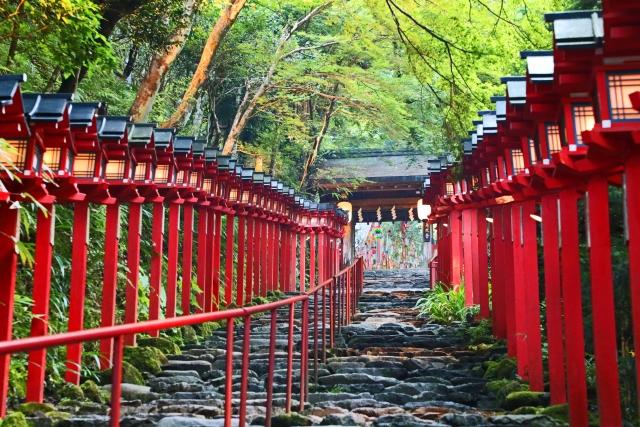
Kifune Shrine is located in Sakyo Ward, Kyoto City, and is considered the head shrine of approximately 2,000 water deities worshipped across the country. The shrine consists of the Honmiya (main shrine), Yui-no-yashiro (associative shrine), and Okumiya (inner shrine), situated along the Kifune River from downstream.
Visitors traditionally participate in the 'Sanja-Mairi' or 'Sanja-Mōde' pilgrimage, which involves visiting the three shrines in the order of the Honden, Okumiya, and Yui-no-yashiro.
Although it still remains customary order for visit the shrines, currently there is no specific rule regarding the correct worship sequence according to the shrine itself.
The place name for the shrine is pronounced 'Kibune,' but due to the shrine's dedication to the water deity, it is pronounced 'Kifune' without the dakuten (voiced mark).
This pronunciation carries the wish for the water to remain pure and clear forever.
As historical records specifying the shrine's founding are lacking, the exact date of its establishment remains unknown.
However, records indicate that the shrine's buildings were reconstructed in the 6th year of the Hakuhō era (666 AD), underscoring its considerable historical significance.
T he Origin of Kifune Shrine
There are various theories about the origin of Kifune Shrine, but according to the shrine's records, it is said that Kifune Okami descended from the heavens to the middle of Mount Kifune on the day of the Ushi (Ox) in the Ushi (Ox) month of the Ushi (Ox) year in ancient times, with the purpose of protecting the peace of the country and its people.
This legend led to the tradition of holding a festival on the day of the Ushi (Ox) at Kifune Shrine.
The sacred rock where Kifune Okami is said to have descended, known as the Kagami-iwa (Mirror Rock), is considered a sacred stone. As such, it is currently off-limits, and no one is allowed to enter.
Another legend tells of the origin of the Kifune Shrine, attributing it to Empress Tamayori-hime-no-mikoto, the mother of the first Emperor, Emperor Jimmu.
According to this legend, she said, 'Let's build a shrine where my boat stops. If we do that, the country will prosper, and happiness will come to the people.' She then sailed from the present Osaka Bay and reached the land of Kifune, where she built a shrine, marking the beginning of the Kifune Shrine.
Anecdotes and legends passed down at Kifune Shrine

At Kifune Shrine, one of Kyoto's foremost historical sites, a myriad of anecdotes and legends have been passed down through the ages.
Here, we present some of the well-known tales and legends associated with the Kifune Shrine.
I s Kifune Shrine a sacred place for the Ushi-no-Koku-Mairi !?
Kifune Shrine is renowned as a sacred site for the 'Ushi-no Koku Mairi' ritual, and there is a tale from the Heian period that recounts the regular practice of this ritual during those times.
The 'Ushi-no-Koku Mairi' ritual involves visiting the shrine during the hour of the Ox (around 1:00 AM to 3:00 AM), as per the ancient timekeeping system known as the 'Engiho.'
During this ritual, participants offer prayers at the shrine and drive a straw doll, representing a hateful person, into the trees on the shrine grounds using a five-inch nail.
Originally, there was a legend that worshipping at the shrine during the 'Year of the Ox, Month of the Ox, Day of the Ox, Hour of the Ox' would grant access to the tremendous power of the deity, Kifune Okami.
Over time, this practice evolved into the sacred tradition of the 'Ushi-no-Koku Mairi.'
※Enkiho: a timekeeping system used until the Edo period, which designates the hour of the Rat (ne) as 11:00 PM and counts each zodiac sign in two-hour increments. As the Ox is the second sign, the 'Ushi no Koku' corresponds to 1:00 AM to 3:00 AM.
The linked article below introduces the legend of 'Hashihime,' who performed the 'Ushi-no-Koku Mairi' at Kifune Shrine to transform into an oni (demon). If you're interested, please take a look.
<菊野大明神の内部リンク挿入予定>
K ifune Shrine is the Birthplace of Ema
The origins of the ema, the wooden plaques commonly seen in shrines across Japan today, are said to be traced back to the Kifune Shrine.
In ancient times, when periods of drought or prolonged rainfall occurred, successive emperors would send imperial envoys to Kifune Shrine.
During rituals to pray for rain or fair weather, it was customary to offer a black horse for rain prayers and a white horse for clear weather prayers.
Over time, the ceremonies were simplified, and instead of actual horses, wooden plaques with horse drawings, known as 'Ita-tatemuma' (板立馬), began to be dedicated. It is said that this practice laid the foundation for the modern ema.
At Kifune Shrine, there are three types of ema: 'Shiro Uma Kuro Uma' (White Horse, Black Horse), 'Izumi Shikibu' (a famous Heian period poet), and 'Ryujin' (Dragon God).
Recently, there are also cute ema featuring seasonal themes like cherry blossoms and autumn leaves.
When you visit Kifune Shrine, why not try dedicating an ema at the birthplace of this tradition? You can write any wishes on the ema and your wishes might come true.
O kumiya is One of Three Major Dragon Caves in Japan

It is said that beneath the main hall of the Okumiya, where Empress Tamayori-hime is believed to have erected a shrine, there exists a massive dragon hole.
In essence, a dragon hole is a power spot where the Earth's energy is said to surge forth. The dragon hole at Kifune Shrine is considered one of the Three Great Dragon Holes in Japan, alongside the 'Muro Dragon Hole' in Nara and the 'Bizen Dragon Hole' in Okayama.
While it is forbidden for anyone to lay eyes on it, experiencing the divine energy at the Okumiya is a compelling reason to visit during your pilgrimage!
Kifune Shrine’s Enshrined Deity and Blessings

What kind of god is enshrined at Kifune Shrine, which has been deeply worshiped by successive imperial courts since ancient times, and what kind of blessings does it bring?
E nshrined deity
Honmiya (Main shrine)
Takao-kami-no-kami, enshrined in the Honmiya, is a child of the deity Izanagi-no-Mikoto.
Revered as a 'Water Source Deity,' Takao-kami-no-kami is believed to govern the ability to summon clouds to bring rain and to store and release rainwater into the ground, as the role of a deity connected to water and its sources.
Yui-no-yashiro (Associative shrine)
In the Yui-no-yashiro, the deity enshrined is Iwanaga-hime-no-Mikoto, known as a deity of matchmaking.
According to an ancient tale, when Ninigi-no-Mikoto, the great-grandfather of Emperor Jimmu, expressed his desire to marry Konohanasakuya-hime, the sister of Iwanaga-hime-no-Mikoto, Iwanaga-hime-no-Mikoto's father suggested that he should also take Iwanaga-hime-no-Mikoto as his wife.
However, Ninigi-no-Mikoto accepted only Konohanasakuya-hime, and, surprisingly, sent Iwanaga-hime-no-Mikoto back.
Feeling the shame of being rejected, Iwanaga-hime-no-Mikoto hid herself and decided to bestow good marriages upon people, saying, 'Let me bear this sorrow alone and grant people good matches.' It is said that she then established herself in this area.
Okumiya (Inner shrine)
Earlier, Okumiya, we introduced at 【Okumiya is One of Three Major Dragon Caves in Japan】, enshrines the deity Takao-kami-no-kami same as the Honmiya.
However, according to some accounts, it is said that Okumiya also venerates Tamayori-hime-no-Mikoto and Kurao-kami-no-kami, the deity associated with darkness.
B enefits
Kifune Shrine is believed to bring blessings in various aspects, including 'Unki Ryusho' for elevating one's fortune, 'Enmusubi' for connecting the bonds of relationships, and 'Shogan Joju' for the fulfillment of various wishes.
Additionally, the Kifune Shrine is renowned as one of the prominent power spots in Japan.
The term 'Kifune' was historically written as '気生根,' signifying a place where energy is generated.
As a result, Kifune Shrine is said to evoke internal energy when coming into contact with its divine atmosphere.
Main events at Kifune Shrine
At Kifune Shrine, which enshrines the deity of water, various festivals and rituals have been held since ancient times to pray for the country's fertility and the peace of its people.
Here we will introduce the 'Setsubun-sai', 'Kifune-sai', and 'Kifune-no-Mizu Matsuri' from among the festivals of the Kifune Shrine.
S etsubun-sai
The 'Setsubun-sai (Setsubun Festival)' held annually on February 3rd, is a celebration where people drive away evil spirits and pray for good fortune by dispelling demons.
During the festival, there are ceremonial events such as the 'Meigen Shinji,' a ritual to purify the atmosphere with the sound of plucked strings, and the 'Mamemaki' ritual, where beans are scattered.
The tradition of throwing beans to expel demons on Setsubun is said to have originated from Kifune Shrine, as documented in the medieval Otogi-zōshi (a type of illustrated narrative literature) titled 'The Tale of Kifune.
K ifune-sai
The 'Kifune-sai (Kifune Festival)' is the Reisai※ which means the annual festival of the Kifune Shrine, held on June 1st.
Commencing at 11 AM, the morning session involves rituals at the Honmiya (main shrine).
In the afternoon, a mikoshi (portable shrine) carrying the spirit of Kifune Okami is respectfully paraded from the Honmiya to the Okumiya along a designated route.
※ Reisai: A major festival considered the most important among the various events held at a shrine.
K ifune-no-Mizu Matsuri (Tanabata ritual)
The 'Kifune-no-Mizu Matsuri (Kifune Water Festival)' has its roots in ancient rain-making rituals, expressing gratitude to the deity of Kifune, who governs the water source.
During the festival, prayers are offered for favorable weather throughout the year and for the continued blessing of moderate rainfall.
Held annually on July 7th, so it is also referred to as the 'Tanabata Shinji' due to its association with the 'Star Festival.'
On this day, in addition to the Water Festival, the traditional 'Sasa no Sekku' (Bamboo Grass Festival) is also celebrated.
【Three shrines】 Highlights of Each Three Kifune Shrines
If you plan to visit Kifune Shrine, be sure to explore the three main shrines: Honmiya (main shrine), Yui-no-yashiro (associative shrine), and Okumiya (inner shrine).
Here, we'll introduce the highlights of each shrine for you to enjoy♪
T ry Water Fortune-telling at the Main Shrine!
Originally, the Honmiya (main shrine) was located at the position of the Okumiya (inner shrine), but it suffered damage from flooding. In 1055 (the third year of Tenki), it was relocated to its current site.
Since then, there have been over 30 reconstruction projects, with the most recent shrine reconstruction taking place in 2005 (the 17th year of Heisei).
A notable feature of the Honmiya is the 'Mizu-ura Mikuji' (water-based fortune-telling). Visitors float a piece of paper on the sacred water in front of the shrine to receive their fortune.
The sacred water that springs forth here is sourced from the waters of Mount Kifune, and visitors can also drink it using a ladle.
Additionally, there is 'Goshinsui Ramune' (Ramune soda made with sacred water) available for purchase, providing a unique and refreshing experience.
Be sure to give it a try!
Y ui-no-Yashiro (associative shrine) is a Power Spot for Matchmaking♡
The Yui-no-yashiro (associative shrine), affectionately known as the 'Love Shrine,' has long been a renowned love-power spot in Kyoto. ♡
It gained fame as a place visited by the female poet Izumi Shikibu during the Heian period when she was troubled by her husband's change of heart.
A monument dedicated to Izumi Shikibu's poetry is constructed within the precincts.
The appellation 'Love Shrine' originated from a legend that when Izumi Shikibu offered a poem praying for a reunion with her husband, her wish miraculously came true.
Even today, the shrine is reputed for its blessings in love, marriage, and reconciliation.
The 'Musubi-bumi' wishes, especially those for matchmaking, are immensely popular, and the shrine's designated area for tying vows is adorned with numerous heartfelt wishes!
L et's Feel the Divine Spirit at Okumiya
The Okumiya is the sacred ground where Kifune Shrine was originally established.
In front of the main shrine, there is a large 'Funagata-ishi' (boat-shaped stone), and it is said that within this stone, is the hidden boat of Princess Tamayori-hime-no Mikoto, who arrived from Osaka Bay.
When viewed from a distance, it indeed appears to resemble the shape of a boat.
Furthermore, the Okumiya is the location of the Dragon Hole, which is one of the reasons Kifune Shrine is considered a power spot.
It is believed that coming into contact with the divine atmosphere enriches the spirit, so be sure to pay a visit and receive the divine energy!
D on't Miss the Momiji Toro (maple lanterns) During the Autumn Leaves Season♪
In Kifune, the 'Kifune Momiji Toro' (Kifune Maple Lantern Festival) takes place annually from early to late November.
During this event, the district from the Honmiya to the Okumiya is illuminated, offering a breathtaking view of the beautifully lit autumn leaves.
One of the most enchanting views can be experienced along the approach to the Honmiya.
The collaboration between the Kasuga lanterns lining the approach and the autumn foliage is so stunning that it can take your breath away.
Moreover, the seasons of cherry blossoms and snow also provide picturesque landscapes, so when visiting, be sure to witness the changing scenery throughout the four seasons.
About How to Get to Kifune Shrine and Parking Lot
We will share how to get to Kifune Shrine, parking, visiting hours, etc.
H ow to Get to Kifune Shrine
Address
〒601-1112
180 Kurama Kifunecho, Sakyo Ward, Kyoto City
Phone Number
+81 075-741-2016
Access
【Public Transportation】
By Train: Get off at the Eizan Electric Railway Kurama Line's "Kibuneguchi Station" and walk for approximately 30 minutes.
By Bus: Get off at the "Kibune" bus stop, which is served by Kyoto Bus (Route 33), and walk for about 4 minutes.
【Car】
・Approximately 40 minutes north from Kyoto Station
・Approximately 50 minutes north from the Kyoto East Interchange on the Meishin Expressway
・Approximately 50 minutes north from the Kyoto South Interchange on the Meishin Expressway
As Kifune Shrine is located at a distance from the city center, it is recommended to use a combination of train and bus for your visit.
Although it's possible to walk from the nearest station, 'Kibuneguchi,' there is a bus stop called 'Kibuneguchi Ekimae' just a 2-minute walk from the station. Taking the Kyoto Bus (Route 33) from there to the 'Kifune' bus stop will provide a smoother journey to the shrine.
A bout the Kifune Shrine Parking Lot
There are parking lots available at both the Honmiya (main shrine) and Okumiya (inner shrine) of Kifune Shrine.
Please note that the parking capacity is limited to 10 cars at the Honmiya and 15 cars at the Okumiya. Therefore, if possible, it is advisable to use public transportation.
Especially during the autumn foliage season, congestion is expected, and the parking lots may be full!
If you are coming from a distant location by car, you may consider using parking facilities around Kyoto Municipal Subway 'Kokusai-Kaikan Station' or Eizan Electric Railway 'Demachiyanagi Station.'
From there, you can use trains and buses to reach Kifune Shrine smoothly.
K ifune Shrine Opening Hours and Worship Fees
The main entrance of Kifune Shrine, known as the Honmiya, opens at 6:00 AM.
Please be aware that the closing time varies during two periods: May to November and December to April.
May 1st to November 30th / 6:00 AM to 8:00 PM
December 1st to April 30th / 6:00 AM to 6:00 PM
※ Reception for offerings such as 'Mikuji' (water fortune-telling), charms, and 'Goshuin' (sacred seal stamps) is available from 9:00 AM to 5:00 PM.
Special opening hours apply during the New Year period.
Admission is free.
※ Opening hours and admission fees are subject to change. Please check the latest information on the official website.
Recommended sightseeing spots around Kifune Shrine
Lastly, we will introduce recommended sightseeing spots around Kifune Shrine.
When you go to Kifune Shrine, be sure to stop by the following sightseeing spots♪
K urama-dera Temple
Kurama-dera Temple is the head temple of the Kurama Shingon sect and a popular destination often visited in conjunction with the Kifune Shrine!
Nestled on Mount Kurama, the temple houses the Komyo Shinden Hall, where the Guardian Deity Sanat Kumara, said to have descended to this location 650 years ago, is enshrined.
To reach the main hall and golden hall from the mountain gate, visitors ascend the winding Kurama Ninety-Nine Turns Path, covering approximately 1 km.
Although a cable car is available, many prefer to make the journey on foot as Kurama is considered a sacred mountain itself.
It's a wonderful opportunity to enjoy nature and take a leisurely stroll.
We highly recommend exploring and savoring the natural beauty along the way.
M omiji Tunnel
Near Kifune Shrine, between Ichihara Station and Nino-se Station, you'll find the "Momiji Tunnel," a picturesque spot known for its autumn foliage.
This approximately 250-meter stretch is adorned with 280 maple trees, offering vibrant green leaves in early summer and transforming into a captivating display of autumn colors in the fall.
The foliage, crowding on both sides of the railway tracks, creates a stunning and powerful spectacle.
You can experience this scenic view by taking the Eizan Electric Railway from 'Demachiyanagi Station' bound for 'Kurama Station'.
K ifune River
The Kifune River, flowing near Kifune Shrine, is renowned for its traditional "kawadoko" or riverside dining platforms, which are a popular feature of Kyoto's summer scenery.
Along the banks of the Kifune River, you'll find numerous restaurants and inns where you can enjoy a variety of Kyoto cuisine while listening to the gentle murmur of the river. This experience allows you to savor Kyoto's gourmet delights amidst the soothing sounds of the flowing water.
Many visitors, having completed their visit to Kifune Shrine, choose to stop by these establishments, making it a must-visit spot, especially during the hot summer months.
The area is known for being about 10 degrees cooler on average than Kyoto City, providing a refreshing escape from the heat.
In Conclusion
Kifune Shrine, with its numerous tales and legends, is a place filled with a sense of ancient romance and mystique.
Renowned as a power spot for matchmaking, it has not only the blessings of harmonious unions but also the increased fortune and the fulfillment of wishes.
When visiting, be sure to explore all three shrines: Honmiya(main shrine), Yui-no-yashiro (associative shrine), and Okumiya (inner shrine).
Moreover, during your visit to Kifune, you can immerse yourself in seasonal events such as the riverside dining platforms (kawadoko) or the mesmerizing Momiji lantern festival.
Keep an eye on seasonal events and nearby attractions to make the most of your outing and please have wonderful memories with the unique experiences that each season brings!
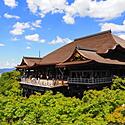
In this article, we provide info about Kiyomizu-dera Temple, including its history, highlights, and recommendations for tourism!
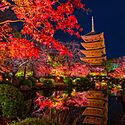
In this article, a Wagokoro editorial team member from Kyoto has carefully selected 'Top 20 Recommended Autumn Colors Spots in Kyoto'!

